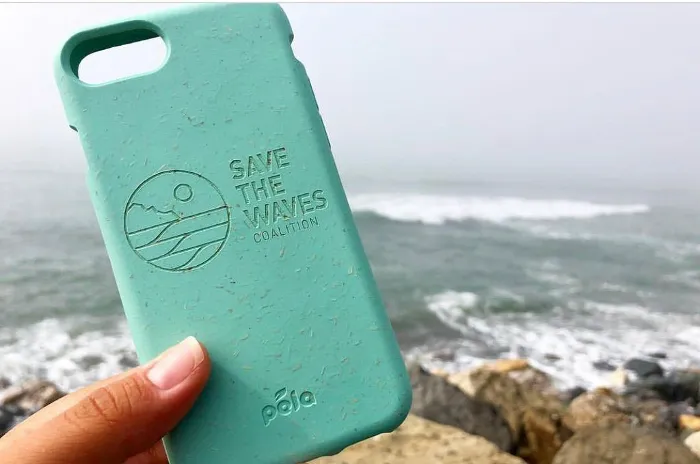Review: Pela Phone Cases - Protecting Your Phone and the Environment

-
Pela Phone Cases: A Sustainable Solution
-
Pela Case Story
-
My Final Thoughts on Pela Phone Cases
Did you know that the average American will replace his or her phone every 2.6 years? This means he or she will probably need to buy a new phone case too. Or run a greater risk of getting the dreaded cracked screen.
For me personally, a phone case is a necessity. I would be replacing my phone every couple of months with the amount of times that I accidentally dropped my phone. If this sounds familiar, don’t worry you are not alone!
Even the most careful person will sometimes drop their phone. Accidents do happen. Approximately 45% of smartphone owners will accidentally damage their phones. One of the obvious and best ways to protect your phone is by buying protective cases and screen protectors.
Unfortunately, the majority of phone cases are made from plastic. A material that is horrible for the environment and can persist for thousands of years. Most plastic or “polymers” are synthesized from primary chemicals generally coming from oil, natural gas, or coal.
If all phones were the same, this plastic problem would not be as bad. Unfortunately, phones come in all different sizes, and buttons and cameras are placed in different areas of a phone. Therefore, each phone requires a specific case, which leads to dumpsters full of outdated plastic phone cases.
So the big question is, is there a good, affordable phone case that is also sustainable?
The answer is yes. The answer is the Pela Case.
Pela Phone Cases: A Sustainable Solution
Pela phone cases are made from flax plants or flax fibers. The company collects and uses flax waste from farms in Canada to create their cases. However, only a portion of the total content ends up as biobased. The overall material content is 45% biobased with the remaining 55% of non-renewable feedstock.
While it is unfortunate that the cases are not completely biobased, the company does seem to be heading in the right direction.
The company is working towards improving its formula and increasing the biobased content. As the company states on its website, “We believe 45% biobased is better than none.”
Pela does claim that the phone cases are 100% compostable, which seems to indicate that the remaining 55% content is not petroleum-based.
As stated on their website, the case is also free of lead, cadmium, BPA, and phthalates.
Nevertheless, Pela cases are better for the environment than plastic phone cases. Compared to plastic cases, Pela cases have 25% less carbon emissions, 35% less water usage, and 70% less waste production.
Pela Case Story
The founder, Jeremey Lang, created this company after going on a family vacation in Hawaii and seeing the plastic pollution problem.
He came up with the idea of using flax waste material after seeing his town’s flax fields intentionally burned every year. He wondered if there could be a better use for the leftover flax straw instead of just burning it.
With a good idea and the goal of a waste-free future, the Pela case was born.
Today, more than 641,165 people have switched over to Pela cases. In other words, this is equivalent to saving 352,640 pounds of plastic from being produced!
The Pela company also became a certified B corporation in 2019 with a score of 80.3.
Although 80.0 is the minimum score required to become a B corporation, it shows they have become a business for good.
For reference, the median ordinary business score is around 50.9. To be a B corporation, a company must be impactful in multiple areas.
Pela's current score is 102.2, which shows that they are significantly improving. They have great impact area scores for their workers (29.6) and the environment (42.1).
Pela was also part of the 1% for the Planet network when I started following them in 2019. Pela donated 1% of its gross sales to various environmental non-profit organizations. However, it seems that they are no longer part of this network.
Lastly, the company is also certified as carbon neutral by Climate Neutral, an independent non-profit organization. Climate neutral measures a company’s carbon footprint and offers the opportunity to purchase carbon credits to offset the carbon emissions.
For example, Pela’s total carbon footprint for 2019 was calculated to be 1,109 tCO2e. Pela was able to offset its entire carbon footprint by purchasing $5,119 of verified carbon credits that came from forests and landfills.
My Final Thoughts on Pela Phone Cases
Not only do our customers appreciate the quality and sustainability of Pela phone cases, but they also love that each purchase contributes to environmental causes.
Pela phone cases have been praised for their practicality and functionality.
The cases are slim and lightweight, adding minimal bulk to your phone while providing reliable protection against scratches, drops, and other accidents.
The raised edges around the screen and camera cutouts ensure your device remains safe from damage, even if it falls face down.
The precise cutouts also allow for easy access to all buttons, ports, and features of your phone.
Pela phone cases have a soft and comfortable texture, providing a secure grip and preventing your phone from slipping out of your hand.
Whether you have the latest iPhone or a popular Android device, there is a stylish Pela phone case available for you.
Overall, Pela Phone Cases combines style, functionality, and eco-friendliness in a way that no other phone case brand has managed to achieve. I highly recommend them to anyone who wants to protect their phone and make a positive impact on the environment.
-
Pela Phone Cases: A Sustainable Solution
-
Pela Case Story
-
My Final Thoughts on Pela Phone Cases



